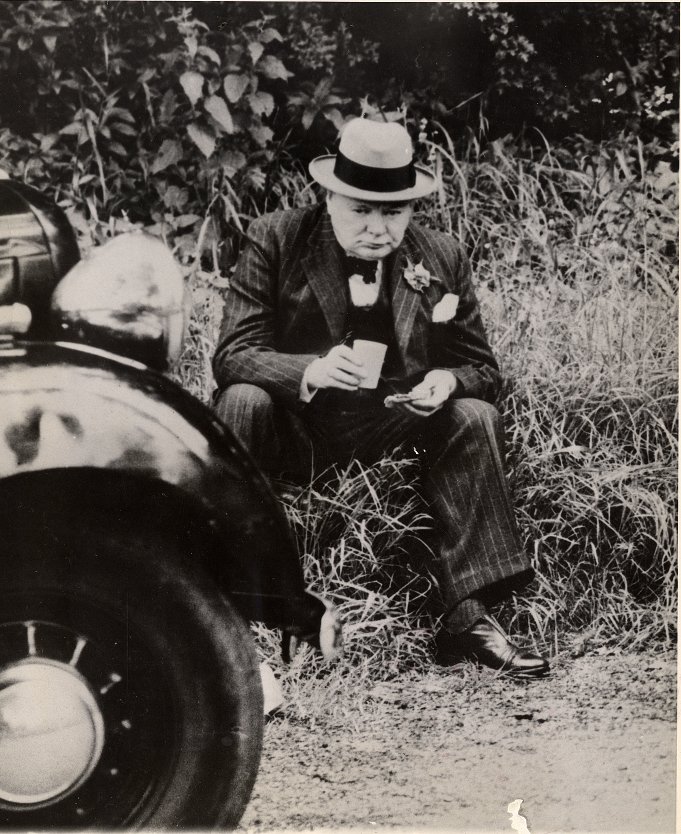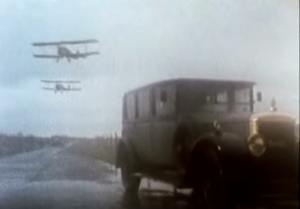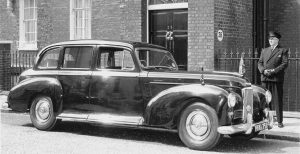
Cars & Churchill: Blood, Sweat & Gears (2) Daimlers…
Having written about cars and Winston Churchill for fifty years, I finally produced a piece on them both. From exotica like Daimler, Napier and Rolls-Royce to more prosaic makes like Austin, Humber and Wolseley, the story was three decades in coming. I am satisfied that it is now complete.
Part 2, continued from Part 1: Excerpt only. For footnotes, all illustrations and a roster of Churchill’s cars, see The Automobile, (UK), August 2016. A pdf of the article is available upon request: click here.
Wolseley to Austin
In the early 1930s Churchill switched from Wolseley to Austin cars: small fours and big sixes. One of the former, a 1938 Austin 10 Cambridge, was the Chartwell workhorse. It was driven primarily by longtime secretary Grace Hamblin. It was acquired in the 1960s by the 6th Marquess of Bath, who restored and displayed it at Longleat. In 2014 it made £66,000 at auction. Sir Winston referred to it as a “true blue” British motorcar.
The present of a Daimler
In 1929 Churchill lost almost all he had in the Wall Street crash, and two years later went on a North American lecture tour to recoup his losses. Back home, his friend Brendan Bracken was soliciting donations to buy Churchill a new car, a Daimler 35. It was waiting in London: a £2000 landaulette limousine by Barker. Over 140 affectionate friends contributed, among them the Prince of Wales, Charlie Chaplin, John Maynard Keynes, Harold Macmillan and, of course, his longtime and close friend, the Duke of Westminster.

The Daimler was a 5.8-liter sleeve-valve six, then in its last year. Churchill had earlier test-driven a more exotic Double-Six, but the Depression was at its depth and practicality prevailed. “There was some controversy as to whether you would prefer a Rolls-Royce, a Daimler or a Bentley,” Bracken told him. His friends had settled on “the car which is least expensive to maintain.”
Daimler adventures
He liked the Daimler so much that he kept it until the Second World War, repainting it several times. In it he made surreptitious rendezvous with informants who, at risk of their careers, delivered secret reports on German rearmament. In it he paid his last, sad call on Edward VIII at Windsor, who informed him he was abdicating (an act for which Churchill later was grateful).
For a moving episode featuring a lookalike Daimler, as Churchill is warned of German rearmament in the classic documentary “The Wilderness Years” click on this Hillsdale Churchill site and then on the YouTube video.
The advent of war in 1939 found Churchill back at the Admiralty. He sold the Daimler to a London dealer, saying he’d have new one “when the War has ceased.” In 1985, a Daimler 35 said to be his changed hands for £60,500 at Sotheby’s. Found dilapidated in Gloucestershire, it had been restored, and equipped with a bulldog mascot and Churchill coat of arms to emphasize, unnecessarily, its association.
There’s safety in Humbers
In London during the war, Churchill became attached to his bullet-proof Humber Pullmans, government cars skillfully driven by the Royal Army Service Corps. Again Churchill’s fondness for the horsedrawn age was reasserted. When ready to leave on a trip, he would ask not whether the chauffeur was behind the wheel but, “Is the coachman on his box?”

William Rootes founded the Rootes Group, which embraced the marques of Hillman, Humber, Singer and Sunbeam-Talbot. He was a close admirer. The July 1945 election left Churchill out of office and needing a car. Prying him away from his allegiance to Daimler, Rootes sold him a new Pullman. The company let him garage it at Devonshire House, its London headquarters.
When Churchill required a chauffeur, Rootes loaned him John Bullock, a company driver who became a favored part of his entourage. Whenever the boss wanted the Humber he would say, “I think I’ll have the Bullock Cart.”
“The constables saluted humbly”
A biographer recorded Bullock’s frequent experience: Habitually late, Churchill would typically “pile into the Humber around 5:30 for a 7:00 speech a hundred miles distant. As his chauffeur swings into the high road, Churchill crouches, with a flask, on the edge of the back seat and urges him to greater speeds. ‘But the machine is traveling at 85 now,’ the chauffeur will protest. ‘Faster! Whip it up a bit!’ comes the answer.”
Once, doing 80 on a curve, a rear tyre blew and “a van full of irate constables screeched to a halt alongside. They had been trying to catch the runaway for miles.” Realizing who it was, they helped fix the tyre. “Churchill stood off to one side, serenely puffing at a cigar. He made no sign of apology but only got in and cried, ‘Drive off!’ The constables saluted humbly.”
On a campaign trip to Wales, Churchill conversed garrulously with O’Brien, his PR officer. They passed the brandy back and forth. Churchill urged such reckless speed that Clementine Churchill cried: “Please let me out. I refuse to continue this ride.” With the utmost courtesy, Churchill stopped at a country railway station and escorted her to the platform. Then, plying the brandy bottle, he ordered the driver “down the road like a bat out of hell for Cardiff.”
By the time they arrived, what with the brandy and his nerves, O’Brien was “done up—out practically cold. Churchill supervised the laying out of his PRO on a table in the rear of the hall. Then he went ahead and made a rouser of a speech. Afterward, he appeared confused about the origin of O’Brien’s trouble, and expressed the opinion that it was ‘probably something he ate.’”
Concluded in Part 3…







2 thoughts on “Cars & Churchill: Blood, Sweat & Gears (2) Daimlers…”
Thanks, I have since discovered this Daimler was initially registered with an RN plate and delivered to the Admiralty in July 39. Then since reg LL422 in 1947, it was sold to the public and 1987 reallocated a 1939 number plate ESU148 by the DVLA following the Daimler owners club research with the British Science Museum. The Churchill suggestion was made because he was made First Lord of the Admiralty again in 1939, when this car had just been delivered to them.
–
Rob, thanks for the information. That Daimler may have gone to the Admiralty but I don’t know if WSC ever used it. I found no record of him using anything but government pool Humbers once the war started. He certainly didn’t own another Daimler after the ’32 Model 35 (GW 7470) which he sold when the war started. A ’32 purporting to be the same car has been restored. -RML
Very interesting article. I am currently researching a Daimler Limousine with reg ESU 148. A 1939 car bought from Churchills estate. I wondered if you knew of this one?
–
WSC owned only one Daimler, which has been restored, and it is early 30s not a 39.-RML
Comments are closed.